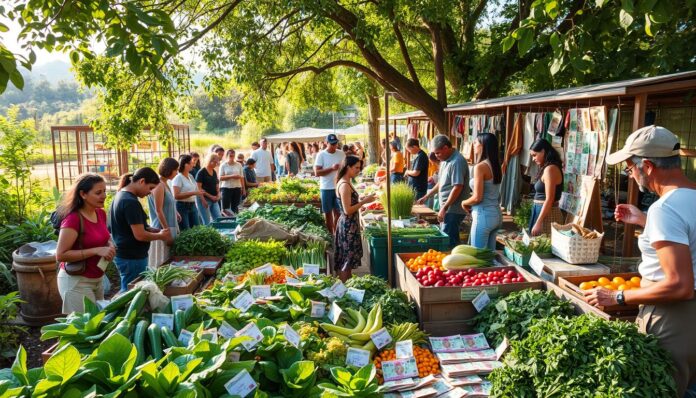In the Berkshires of Massachusetts, almost 400 local businesses take BerkShares. This local currency helps keep money in the community. It supports local currency permaculture and promotes sustainable economics. It’s like nutrient recycling in composting, a core principle of permaculture and sustainable economics.
Key Takeaways
- Local currencies help small businesses and encourage buying locally, reducing carbon footprint.
- They strengthen community ties and promote sustainable economic habits, key for community resilience.
- Practical uses like community exchange systems and local gardens make local currencies work.
- Trust in the currency is vital for its success and community support.
- Starting small with local currencies can increase community use and support over time.
- Local currencies tackle social and economic challenges, making them a valuable tool for community resilience and sustainable economics.
- They help create a more sustainable and fair economic system, aligning with permaculture and community resilience.
Understanding Local Currency in the Context of Permaculture
Local currencies are special money types used in certain areas. They work alongside the national money to help local businesses and services. This idea is linked to alternative currency systems, which help local economies grow and support regenerative agriculture.
In permaculture, local currencies are key. They help build a strong grassroots economy by boosting local trade and community ties. Studies show that community currencies can keep up to 80% of money within the community.
Definition of Local Currency
A local currency is money made for use in a specific area, like a town or city. It helps local businesses and can be used with national money.
Historical Context of Local Currencies
Local currencies have been around for a long time, starting in the early 20th century. Lately, more communities are starting their own currency systems.
Examples of Local Currency Initiatives
- The Bristol Pound in the UK
- The Chiemgauer in Germany
- Local initiatives in the United States
| Local Currency | Location | Year Established |
|---|---|---|
| Bristol Pound | UK | 2012 |
| Chiemgauer | Germany | 2003 |
Benefits of Local Currency for Permaculture Communities
Local currencies can greatly help permaculture communities. They make local economies stronger, encourage sustainability practices, and build community resilience. Using local currencies helps communities become more self-sufficient and circular. This reduces their need for outside systems and promotes a fairer way of living.
The local exchange trading system keeps money in the community. It supports local businesses and services, building a sense of unity and cooperation. This approach also helps with ecological finance by cutting down on the need for outside resources and boosting local economic growth.
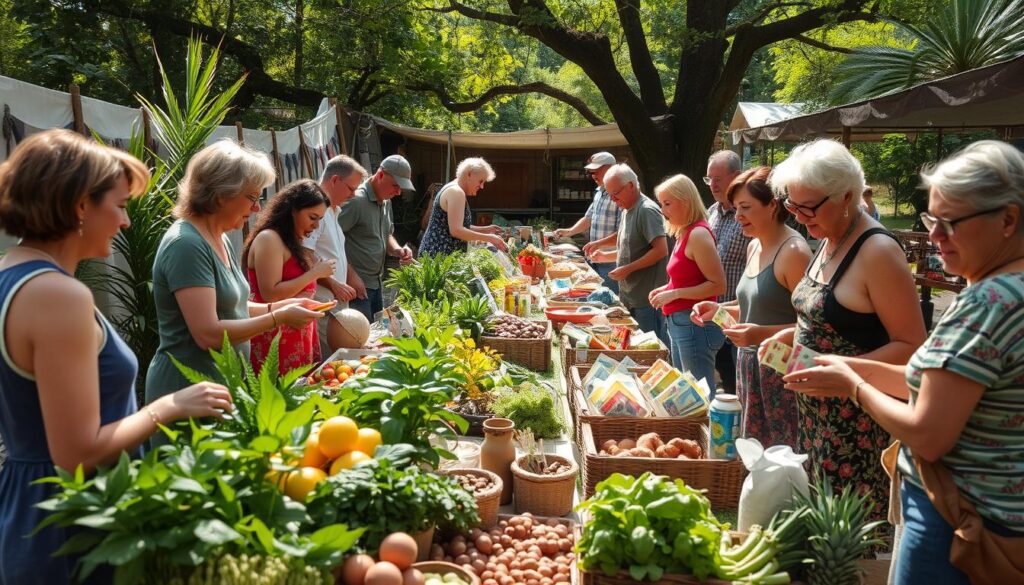
Strengthening Local Economies
Local currencies can make local spending go up by 3-6 times compared to national currencies. This is because local currencies keep wealth in the community. They don’t let it flow out to bigger economies.
Encouraging Sustainable Practices
Permaculture’s principles, like caring for the earth and people, support local currencies and green practices. By encouraging local shopping, communities can cut carbon emissions by up to 20%. It also raises awareness about living sustainably among residents.
Key Principles of Permaculture
Permaculture is a design system that aims to create sustainable living systems. It is guided by permaculture principles that focus on sustainable agriculture and community development. These principles help create a more resilient and equitable world.
Using permaculture principles can greatly benefit the environment and local communities. By adopting sustainable agriculture practices, people can reduce their use of harmful chemicals. This supports community development by providing fresh, local food and building community through gardening.
Ethical Foundations
The ethics of permaculture include caring for the earth, people, and returning surplus. These principles ensure that permaculture systems are sustainable, equitable, and just.
Design Principles
Permaculture design focuses on creating systems that work with nature. It involves observing nature, catching and storing energy, and using renewable resources. This approach ensures that systems are regenerative and sustainable.
Integration with Local Currency Systems
Combining permaculture with local currency systems is powerful for community development. It supports local producers and promotes sustainable agriculture. This helps build a more resilient and equitable local economy.
Types of Local Currencies
Local currency systems come in many forms, each with its own special features. They aim to help permaculture communities grow in a sustainable and fair way. Examples include community currency and alternative exchange systems, which boost local economies and community spirit.
For example, time banks, community exchange systems, and local trade networks are types of local currencies. They help local producers, encourage green consumption, and make communities stronger. The LETS system is one, where goods and services are exchanged, not money with value like silver.
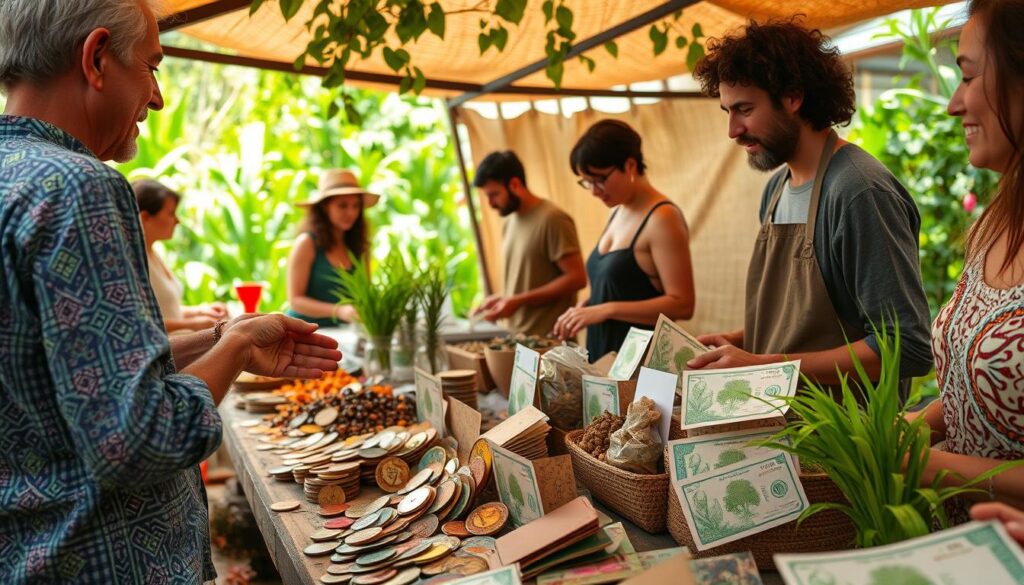
- Time banks: These systems use time as a unit of exchange, allowing individuals to exchange time and skills rather than money.
- Community exchange systems: These systems use a medium of exchange, such as a local currency, to facilitate transactions within the community.
- Local trade networks: These systems connect local producers and consumers, promoting local economic growth and community engagement.
These systems aim to build a better economy that values community and the environment. By using local currencies, communities can lessen their dependence on national money. This helps them grow their local economies and develop in a more sustainable way.
Strategies for Creating a Local Currency
Creating a local currency needs careful planning. It’s important to engage and educate the community about its benefits. This builds trust and encourages people to participate, which is key for success.
Another important part is sustainable economics. The currency should encourage spending locally and support community development. This way, it strengthens local economies and promotes sustainable practices.
- Developing a clear understanding of the community’s needs and goals
- Designing a currency that is easy to use and understand
- Establishing a system for exchanging the local currency for national currency
- Encouraging local businesses to accept the local currency
By using these strategies, a local currency can support community development and sustainable economics. It can help build a stronger, more resilient local economy. This contributes to a more equitable and sustainable society.
Case Studies of Successful Local Currencies
Local currencies have made a big difference in many places around the world. They help communities grow and support sustainable living. For example, the Bristol Pound in the UK has been used since 2012. It encourages people to shop at local stores, boosting the local economy.
In Germany, the Chiemgauer has been around since 2003. It promotes green living and community involvement. This shows how local currencies can help the environment and bring people together.
In the United States, there are many local projects that work well. They help communities and support green living. Some examples include:
- Time banks, where people trade skills instead of money
- Community exchange systems, for trading without using national currency
- Local trade networks, connecting businesses and individuals for local growth

These examples show how local currencies can help communities and the environment. They offer a different way to exchange goods and services. This can make local economies stronger and support greener practices.
| Local Currency | Location | Year Established |
|---|---|---|
| Bristol Pound | UK | 2012 |
| Chiemgauer | Germany | 2003 |
Challenges in Implementing Local Currency
Starting a local currency can be tough. It faces issues like making money work, getting people to use it, and beating the national currency. Ellen Brown points out that over $8 trillion in interest was paid on the federal debt in 24 years. This shows we need new ways to handle money.
Local currencies, like the Bristol Pound, try to keep money in the community. They encourage people to buy local and keep money moving around.
Some big hurdles in starting a local currency are:
- Economic viability: Making sure the currency can be used for many things.
- Community buy-in: Getting local shops and people to use and accept the currency.
- Competition with national currency: Showing the local currency is different and valuable.
To tackle these local currency challenges, we need good planning. We must think about community development and sustainable economics. By understanding these issues, permaculture communities can find ways to succeed. This leads to a better, fairer economy.
Integrating Local Currency with Permaculture Practices
Permaculture aims to make ecosystems self-sufficient and sustainable. Using local currency helps achieve this goal. It supports sustainable agriculture and local producers, reducing reliance on outside systems.
Local currency boosts local food systems. It encourages eating food grown nearby and supports permaculture practices. This leads to a more efficient economy, where resources are used well and waste is cut down.
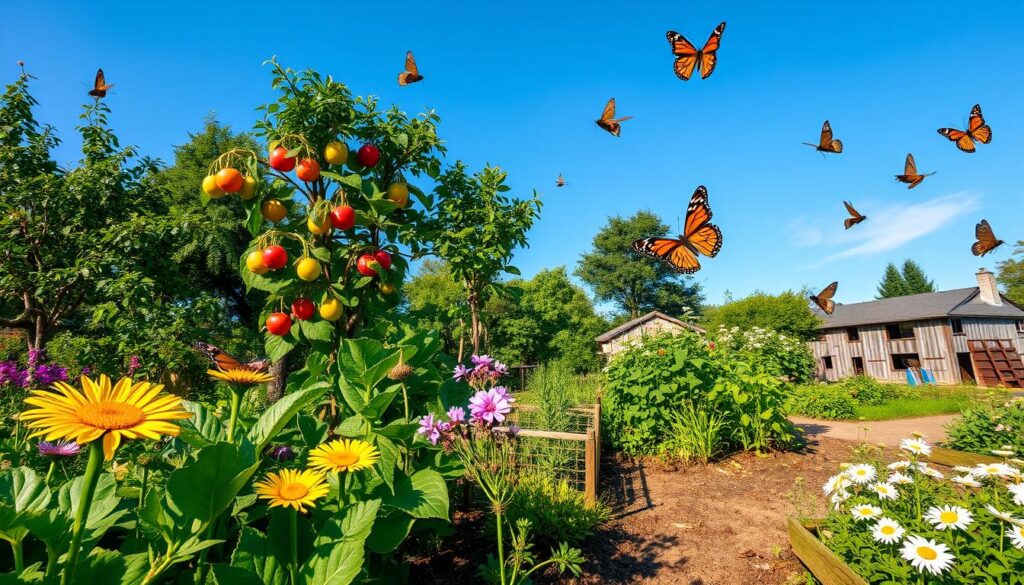
- Supporting local farmers and producers
- Promoting sustainable consumption patterns
- Encouraging community engagement and participation
Local currency makes food systems more resilient and sustainable. This is good for the environment and local people. As more people want local food systems, using local currency with permaculture is key. It supports sustainable agriculture and local economies.
Role of Technology in Local Currency
Technology is key in helping local currency systems grow. It makes local economies more efficient and effective. With digital platforms and mobile apps, communities can boost sustainable economics and local spending.
Studies show that tech helps local currencies thrive. For instance, digital platforms improve transparency and accountability in local transactions.
Some important tech features for local currencies include:
- Secure and reliable transaction processing
- Real-time record-keeping and accounting
- Mobile apps for easy access and convenience
By using local currency tech, communities can build stronger, sustainable local economies. This reduces their need for national currencies. As local currencies grow, tech’s role will become even more crucial.
Technology and local currencies together can lead to a fairer, more sustainable economy. They encourage local spending and support local communities.
| Feature | Description |
|---|---|
| Digital Platforms | Enable secure and reliable transaction processing |
| Record-Keeping Systems | Provide real-time accounting and record-keeping |
| Mobile Apps | Offer easy access and convenience for users |
Building Partnerships with Local Businesses
For permaculture communities to grow, it’s key to team up with local businesses. This means working with farmers to boost local food systems, supporting artisans and craftspeople to highlight unique items, and partnering with local service providers to meet community needs. These partnerships help make communities more economically strong and support sustainable economics.
Here are some ways to build these partnerships:
- Start community-supported agriculture programs to link people with local farmers.
- Make spaces for artisans and craftspeople to show and sell their work.
- Use local trade and barter systems to cut down on money from outside.
By focusing on community growth through local business ties, permaculture communities can build a stronger, more varied local economy. This supports sustainable economics. It also helps the local community and makes the economy more fair and green.
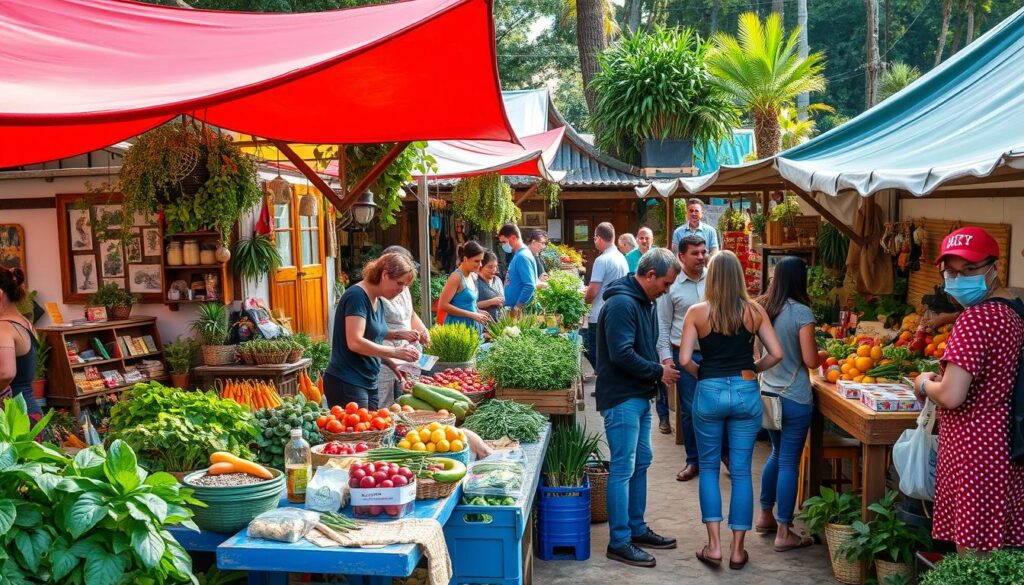
Measuring Impact of Local Currency Systems
Local currency systems in permaculture communities can greatly affect the local economy and social ties. It’s key to watch economic indicators like local trade and GDP growth. This helps see how well these systems work.
But, it’s not just about money. Social cohesion metrics are also vital. These include how active the community is, volunteer rates, and social connections. By keeping an eye on these, communities can spot what needs work and make smart choices.
- Local trade volumes and GDP growth
- Community participation and volunteerism rates
- Social capital and community engagement
- Environmental sustainability and ecological footprint
By looking at these metrics and the local currency impact, permaculture communities can improve their systems. This helps meet the needs of their members and supports a sustainable, fair economy.
Promoting Local Currency Adoption
It’s key to promote local currency use for a strong economy and community growth. Using local currencies helps communities boost their local economy and support green practices.
Here are ways to encourage local currency use:
- Campaign ideas: Organize events and campaigns to raise awareness about the benefits of local currencies and encourage their adoption.
- Incentives for early adopters: Offer incentives to individuals and businesses that adopt local currencies early on, such as discounts or rewards.
- Education workshops and events: Host workshops and events to educate the community about the benefits and use of local currencies.
By pushing for local currency use, communities can build a better, fairer economy. This is done through campaigns, incentives, and education. It helps support community growth and sustainable economics.
| Strategy | Description |
|---|---|
| Campaign ideas | Organize events and campaigns to raise awareness about the benefits of local currencies |
| Incentives for early adopters | Offer incentives to individuals and businesses that adopt local currencies early on |
| Education workshops and events | Host workshops and events to educate the community about the benefits and use of local currencies |
Future Trends in Local Currency and Permaculture
Looking ahead, local currency trends will shape the permaculture future. Communities are exploring new ways to boost local economies. They aim to lessen their dependence on national currencies.
Some trends to watch include:
- Innovations in currency design, such as digital currencies and time banks
- Policy changes supporting local currencies, such as tax exemptions and regulatory frameworks
- Growing interest in sustainable local economies, driven by concerns about climate change and social equity
Recent data shows promise for local currency and permaculture. Local currency trends and permaculture future are closely linked. As communities seek sustainable economics, demand for local currencies and permaculture will rise.
| Trend | Description |
|---|---|
| Innovations in currency design | Digital currencies, time banks, and other innovative currency designs |
| Policy changes supporting local currencies | Tax exemptions, regulatory frameworks, and other policy changes supporting local currencies |
| Growing interest in sustainable local economies | Driven by concerns about climate change and social equity, with a focus on promoting local economic development |
Conclusion
Local currencies in permaculture communities show great promise. They can help build a more sustainable and fair economy. By using local currencies, these communities can become more self-sufficient. This reduces their need for outside systems and promotes a greener lifestyle.
The local currency conclusion is that they are a strong tool for building strong communities. They encourage people to work together and support each other. This leads to a better economy and a brighter future for permaculture.
Some key benefits of local currencies include:
- Supporting local businesses and promoting local economic development
- Encouraging sustainable practices and reducing waste
- Fostering a sense of community and cooperation among members
Looking ahead, local currencies will be key in shaping the permaculture future. By embracing these systems, we can build a more sustainable and fair world. This will benefit us and future generations.
Resources for Further Learning
Starting your journey with local currency systems in permaculture? There’s a lot to learn and support your work. You can find books, articles, online courses, and webinars to help you grow.
Books and Articles on Local Currency
Learn about local currencies’ history and use with books like “The Future of Money” by Bernard Lietaer and “Localizing Money” by Thomas Greco. Read case studies and best practices in academic articles and industry publications.
Online Courses and Webinars
Grow your knowledge with interactive online courses on Udemy and Coursera. Keep up with new trends and strategies by joining webinars from sustainable economic development groups.
Networks and Organizations Supporting Local Systems
Meet others who share your goals with networks like the International Alliance for Localization and the Post Growth Institute. These groups offer resources, networking, and support for building strong local economies.
By using these resources, you can keep learning, innovating, and working together. This will help create a more sustainable and fair future with local currencies and permaculture.

